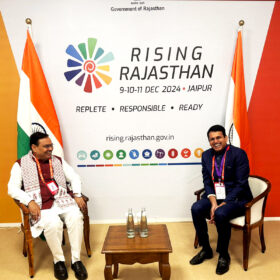Coal-based steelmaking plans jeopardize India’s net-zero target
The “build now, decarbonize later” approach misses the opportunity to develop steel capacity using low-emissions technologies, which could make India a leader in green steel capacity, save on decarbonization efforts later, and reduce current and future stranded asset risk in the industry.
Avaada Group commits INR 1 lakh crore renewable energy investments in Rajasthan
Avaada Group will invest across pumped storage, green hydrogen, green ammonia, wind and solar power projects in Rajasthan.
The Hydrogen Stream: Greenzo Energy, EODev partner to launch Toyota hydrogen fuel cell-powered generators in India
Greenzo Energy will introduce EODev’s emission-free generators powered by Toyota hydrogen fuel cell technology in India and Nepal. This long-term partnership also includes provisions for local assembly of EODev products by Greenzo Energy.
The Hydrogen Stream: IIT Bombay, HSBC green hydrogen programme selects six innovative projects for incubation
The shortlisted technologies and solutions include energy-efficient green hydrogen generators, indigenous hydrogen storage systems for commercial vehicles, and alternative combustion burners to improve air quality.
The Hydrogen Stream: UK scientists call for strict rules for H2 leakage
The Oxford Institute for Energy Studies says addressing hydrogen leakage across the supply chain is crucial to making hydrogen a sustainable energy vector. Italy, meanwhile, has unveiled its national hydrogen strategy, with a focus on its role in the Mediterranean.
Electrolyser cost, efficiency improvement critical for achieving cost viability of green hydrogen
The prevailing levelised cost of Green Hydrogen (LCOH) is 1.75 times that of grey hydrogen and 1.50 times that of brown hydrogen, posing a significant barrier to its adoption. Achieving economic viability of Green Hydrogen to around $2.1 per kg requires a 35%-40% drop in electrolyser prices and a 12%-14% improvement in efficiency apart from supportive policies, says a new report by CareEdge Ratings.
Hygenco secures license for Topsoe’s green ammonia technology
Hygenco Green Energies will leverage Denmark-based Topsoe’s technology for its green ammonia plant in Gopalpur, Odisha.
The Hydrogen Stream: NTPC’s green hydrogen buses start running in Leh
The green hydrogen mobility project at Leh comprises in-situ 1.7 MW solar plant, green hydrogen filling station of 80 kg/day capacity, and five hydrogen intra-city buses.
The Hydrogen Stream: ACME Cleantech, BASF sign agreement to supply green ammonia to Europe
ACME Cleantech and BASF have also signed a Memorandum of Understanding (MoU) to explore further collaboration in the green ammonia business.
NGEL, NREDCAP tie up for 25 GW of renewable energy projects in Andhra Pradesh
NTPC Green energy Ltd (NGEL) and New and Renewable Energy Development Corp. of Andhra Pradesh (NREDCAP) have entered a joint venture agreement to develop 25 GW of renewable energy projects, 0.5 mmtpa of green hydrogen and derivatives projects, and 10 GW of pumped hydro projects in the state.















